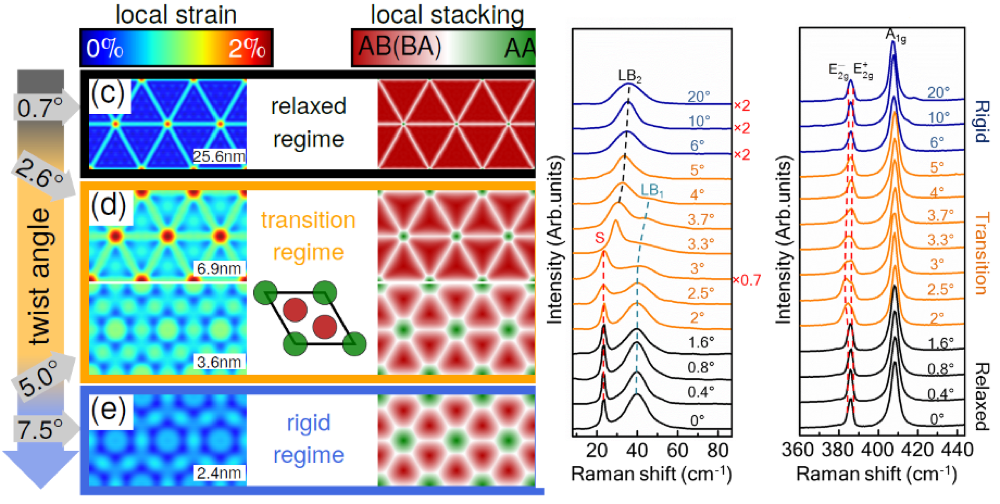 Moire superlattices consist of two monolayers of atomically thin materials, in this case the transition metal dichalcogenide MoS2, stacked on top of each other with a slight rotational misalignment (twist) that creates a moire interference pattern between the atomic lattices of the two monolayers. Moire superlattice periods can range from nanometers to hundreds of nanometers, and create periodic modulation of local atomic alignments, strain, electrostatic potential, and other material properties. In this study, Raman spectroscopy was used to characterize the dependence of phonon energies on twist angle. Theoretical calculations were used to determine local strain and atomic stacking between layers as a function of twist angle. Three regimes of behavior in strain and stacking were found in theoretical calculations; these behaviors are a consequence of the competition between interlayer coupling and strain that leads to local lattice reconstruction that varies with twist angle. The “relaxed” and “rigid” regimes are found to correspond to very different phonon behavior in the low- and high-frequency ranges. The development of a low-energy continuum model for phonons to help explain these results is also establishing a foundation for addressing electron-phonon interactions in these materials.
Moire superlattices consist of two monolayers of atomically thin materials, in this case the transition metal dichalcogenide MoS2, stacked on top of each other with a slight rotational misalignment (twist) that creates a moire interference pattern between the atomic lattices of the two monolayers. Moire superlattice periods can range from nanometers to hundreds of nanometers, and create periodic modulation of local atomic alignments, strain, electrostatic potential, and other material properties. In this study, Raman spectroscopy was used to characterize the dependence of phonon energies on twist angle. Theoretical calculations were used to determine local strain and atomic stacking between layers as a function of twist angle. Three regimes of behavior in strain and stacking were found in theoretical calculations; these behaviors are a consequence of the competition between interlayer coupling and strain that leads to local lattice reconstruction that varies with twist angle. The “relaxed” and “rigid” regimes are found to correspond to very different phonon behavior in the low- and high-frequency ranges. The development of a low-energy continuum model for phonons to help explain these results is also establishing a foundation for addressing electron-phonon interactions in these materials.
Publication citation for this work:
Quan, JM; Linhart, L; Lin, ML; Lee, DH; Zhu, JH; Wang, CY; Hsu, WT; Choi, JH; Embley, J; Young, C; Taniguchi, T; Watanabe, K; Shih, CK; Lai, KJ; MacDonald, AH; Tan, PH; Libisch, F; Li, XQ. Phonon renormalization in reconstructed MoS2 moire superlattices. Nat. Mater. 2021, Early Access. DOI: 10.1038/s41563-021-00960-1 .